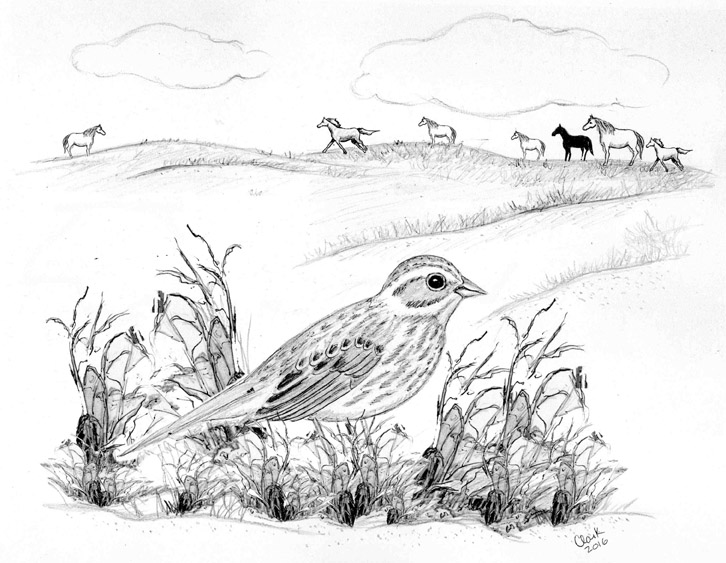
Dear Bird Folks,
I took the attached photo near Eastham’s First Encounter Beach and can’t seem to figure out what the bird is. Any idea?
– Jeff, NY
Yes, I do, Jeff,
I have an idea what that bird is, but first I have to give everyone else some background information. Jeff, who is a birder, a photographer, a birdseed customer and the guy who asked this question, was on the Cape last week and invited me to go birding with him. One of the places we explored was the marsh behind First Encounter Beach. I cautioned Jeff to stay on the trail and watch where he stepped. (Regrettably, this important marsh has turned into another dog park.) Two minutes into our walk we saw a pale, ghost-like sparrow run through the beach grass. The bird was so quick I could barely focus my binoculars on it. Jeff turned and asked me what we had just seen. I replied that I wasn’t sure, but it looked like an “Ipswich Sparrow.” I then grumbled something about wishing we had gotten a photo of the fast-moving bird. This is when Jeff, who can snap his camera faster than CNN can jump to bogus conclusions, said, “Oh, I got a photo and here it is.” (Whoa! He’s even faster than I thought.) And now that everyone knows the back-story, let’s talk about the mystery bird.
After studying Jeff’s photo I wasn’t convinced that my identification was correct, so I forwarded the image to, Keenan. Keenan, who is a local grad-student at UMass, is three times younger than me and four times better at identifying birds. Keenan instantly confirmed that we had indeed seen an Ipswich Sparrow. Jeff was puzzled because he couldn’t find Ipswich Sparrows on his phone’s trusty bird app. But I was thrilled, mostly because I haven’t seen one of these birds in years (and because I rarely ID sparrows correctly). While I was celebrating my personal victory, Jeff wanted to know why this bird wasn’t on his bird app. Here’s why, Jeff.
The Ipswich Sparrow was first identified in 1868 on the beaches of Ipswich, Massachusetts (hence the name). It looks like a typical sparrow, except it’s rather pale and spends its life scurrying through coastal dunes. My old bird book had an entire page dedicated to this bird, but recent books barely mention it all. Why is that? Somewhere along the way researchers decided that the Ipswich Sparrow wasn’t a genuine species, but rather a subspecies of the far more common Savannah Sparrow. This is why it’s not on your trusty bird app, Jeff. But don’t let the technicalities spoil things for you. It’s still a very cool bird, one that is not often seen by many Americans.
Even though Ipswich Sparrows were named after a town in the Commonwealth, they are actually Canadians, but aren’t from mainland Canada. The whole population essentially breeds on Sable Island, which is a thin, crescent-shaped island off the coast of Nova Scotia. The island is twenty-six miles long, but only a mile wide; from the air it looks like an eyelash floating in water. If you were to “beam down” onto Sable Island you would swear you had arrived on the Province Lands of Provincetown. Both areas are surrounded by salt water, have sparse vegetation and consist of lots and lots of sand. But Sable Island has two things that Provincetown doesn’t have. The first thing is a population of 400 wild horses. The horses were brought to the island back in 1760 and have been living there ever since. Over the centuries many of the horses were rounded up and sold to farms or for meat, but those days are over. Today, the horses receive full protection from the Canadian Government. That means no one is allowed to buy them, ride them or turn them into Swedish meatballs. (I’m talking to you, IKEA.)
Sable Island’s other unique creature is the aforementioned Ipswich Sparrow. Only about two thousand pairs of these little birds breed on Sable Island. While this might sound like a lot, it’s basically all there are in the entire world. If some environmental catastrophe were to hit the island, we could lose them all. Why do they only live in one location? Ipswich Sparrows are thought to have evolved on the island from Savannah Sparrows, which have the inclination towards “natal philopatry.” This means they tend to return to the same breeding location year after year, and in this case the location is lonely Sable Island. The isolation resulted in the birds becoming lighter in color, perhaps to better match the sandy landscape. The birds are also heavier than other Savannah Sparrows, causing some officials to argue that Ipswich Sparrows should once again be labeled as a separate species, and I agree. (Then I could sell new, updated bird books. Sweet!)
Reading about Sable Island gives me the urge to visit the area. It would be fun to see the sparrows on their breeding grounds (they only come here in the winter) and to observe free running horses. But it’s not that easy. The island is over 100 miles from the mainland and the government rigorously controls visitations. (In other words, they don’t want boneheads like me messing things up.) The other problem is the weather. Sable Island is in the nasty North Atlantic. Fog, storms and high winds are the rule. Even many of the “approved” visitors eventually have to turn back. This is not Aruba.
Regardless whether the Ipswich Sparrow is a distinct species or a subspecies, Jeff, it’s still a nice bird to see. And given what I’ve read about visiting Sable Island, I think looking for them at First Encounter Beach is the better option…just be careful where you step.